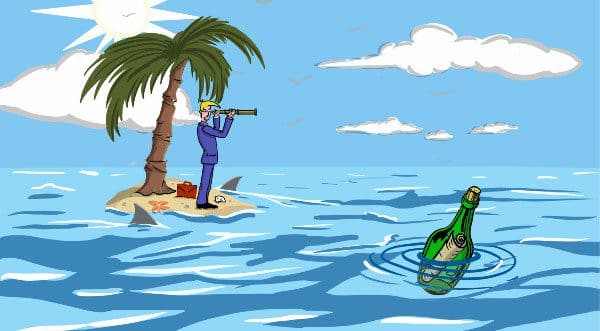Sellers, the active recommendation system can make you more efficient... and open up a world of opportunities for you. What is an active recommendation? How do you develop your network? Loïc Jeunot, a trainer and salesman with a wealth of experience in the field, explains.

"Salespeople who enjoy prospecting should raise their hands! The question has the merit of being asked, as Loïc Jeunot can testify, but it does not arouse much enthusiasm. And with good reason: prospecting is frightening. But these days, the search for new customers is no longer an option. "As we hear about the end of the boom, sales people are going to have to "start" or "get back" to prospecting, and that's good news for them. With one caveat: "The most effective CRM systems will certainly help them to organise their sales activities, but they won't do the prospecting for them.
And while "some salespeople will grit their teeth, others will feel battered by the economic situation ahead, salespeople can rest assured before picking up their briefcases, driving for miles on the road, and sometimes seeing doors close". There is in fact a much more effective alternative, not to be confused with passive recommendation.
From passive to active recommendation

There are two types of recommendation: passive and active. Passive referrals are "simple requests". It involves handing out business cards at the very end of a deal with a satisfied customer. "It seems obvious that a customer who is satisfied with your services and with whom you have established a good relationship is a good ambassador. The first thing to do is to ask them to talk about you by giving them some of your business cards. At that precise moment, your customer will be sincere and tell you that he won't miss out.
But this type of recommendation seems to have its limits. "As soon as your customer leaves the meeting, they go back to their own lives and concerns... and forget all about you. Using this technique, very few salespeople can boast of having closed more than five deals in a year through their passive referral requests."
"But there is a solution that delivers immediate results and is easy to implement: active recommendation.
Defining your targets: categorising your customers
Soliciting customers or prospects to give us the contact details of someone they know, whom we will then contact ourselves to give them the benefit of our advice. This is the principle behind active recommendation.
"We can encourage the introduction of this recommendation system... It's worth asking!
Provided you follow a few key steps.
First, customer categorisation. This involves analysing the customer portfolio and then qualifying the target according to four specific categories. The aim is to target high-potential customers. In other words, to identify customers "who are profitable for us and with whom we have a good relationship", i.e. those we can call on for a recommendation. The method? Write down on a sheet of paper around ten customers who have been identified as such.
"Active recommendation means activating and developing your network thanks to our high-potential customers".
Relationships at the heart of the active recommendation approach
"The method is simple to put in place, makes a lot of sense and requires very little effort. As long as you devote 30 to 40 minutes to it, once a week. In practical terms, once the customers have been categorised, the sales assistant contacts the customers who have already been identified to ask for a recommendation. "We use active recommendation on a daily basis, at least 10 minutes a day, i.e. at least 50 minutes a week", assures a participant trained in the method. The long-term aim is to systemise the approach.
"Active recommendation needs to become a habit for the salesperson".
By identifying the "recommendation moment" or "relaunch day", i.e. the best day of the week to apply this method. "We choose our time slots so that we are most likely to reach our contacts at the right time", continues the participant. A word of advice on the wording: be careful with your catchphrase. And if there's no answer, leave a personalised message on the answering machine, "adapting your message to each situation to give meaning to what you're saying".
Another channel for developing your network is the sales meeting with a customer. The recommendation comes at the end of the sales phase... or at the end of the meeting with the prospect. "You can also ask a prospect for a recommendation. To do this, you need to make a simple request, full of common sense and, above all, have established a good relationship. And you also need to be honest. There's no need to hide the purpose of your request. It's better to explain the reasons, such as the need to expand your network. But "it doesn't seem wise to approach a prospect if you're not sure of the legitimacy of the request".
"Salespeople who adopt active recommendation "put the sales "relationship" back at the centre of their activities, which is what they love and what they do best."
Active recommendation, a successful experiment
"It's a powerful method, which needs some work, but it works almost every time, because it provides a context for the start of the conversation, and builds the confidence of the person we're talking to", says a sales manager who has implemented the approach in his department.
It's a "non-violent" and effective method. "Salespeople will go from 2 or 3 qualified prospects out of 10 to more than 5 out of 10. Provided that the sales manager supports his salespeople to challenge them on a daily basis. The sales manager could set up a performance chart listing the number of telephone calls made each week, and the number of referrals converted into closed deals for each salesperson.
And the results are there. "It's now an automatic process that's proving highly profitable. The approach is already bearing fruit and will continue to do so. It allows us to grow our network, and to have access to the real decision-makers and the most reliable information, which gives us a head start over the competition", explains the sales manager.
Finally, it's essential that you keep the customer or prospect who has provided your contact details informed. In a word, thank them... before they give any further recommendations of their own accord.
"Solicit your best customers, treat yourself and, above all, please your "super customers" - they're just waiting for that... to help you."
What you need to remember: active recommendation is a simple solution to put in place. Provided you follow a few essential steps: define your high-potential targets, then act accordingly by contacting the targets identified as such directly or by meeting with the customer/prospect. The long-term aim is to systematise the approach, with the support of the sales manager.
As a result, sales staff are actively developing their network and becoming more efficient.





